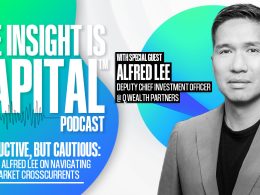by Kevin McCreadie, John Christofilos, Bill DeRoche, Rune Sollihaug, David Stonehouse, Stephen Way, AGF Investments
Equity markets rebounded in the first half of the year as central banks continued their fight against inflation without severe consequences for the economy. Yet the risk of a recession still looms, and investors may not be free and clear of the volatility and losses that put a dent in many portfolio returns in 2022.
Members of AGF’s Office of the Chief Investment Officer* recently sat down to discuss what could happen in financial markets over the next six months and some of the potential ways to navigate them as a result.
Questions and answers that follow have been edited for clarity and length.

Do you believe the economy headed for a recession?
Kevin McCreadie (KM): The short answer is yes, but every country is moving at different speeds towards a recession. Europe’s economy is likely to be the first that falls into one – maybe even next quarter – as they continue to fight much higher inflation than in North America. Meanwhile, in other economies like the United States and Canada, recession also seems inevitable, but may still be several months or quarters away.
This stems largely from the fact that tighter monetary policy (i.e., higher rates) works on a lag, meaning it often takes much longer to negatively affect economic growth than many investors believe it should. At the same time, countries have varying sensitivities to higher rates, in particular as it relates to housing.
In the United States, for instance, homeowners are less impacted by the rise in mortgage rates because many have 30-year mortgage terms that won’t need to be refinanced over the next many years. However, in Canada, mortgage terms are shorter, and more homeowners will have to renew their terms at much higher rates over next few years. In turn, this difference could end up putting more of a dent in the Canadian consumer’s wallet than it does in the U.S. consumer’s, and thus play a role in the timing or magnitude of a recession in each of these countries.
David Stonehouse (DS): The resilience of the economy in the face of rising rates can be attributed in part to residual pandemic benefits and excess savings that are helping prop up consumer spending. Moreover, given this is the first year since 2019 that we are truly clear of the pandemic, demand for services like entertainment and travel has remained strong. But recession risks should rise heading into the winter and spring next year, particularly in the United States, where some economic indicators are starting to suggest cause for concern, including weekly initial jobless claims that have accelerated over the past month and are now at their highest level (four-week moving average) in more than a year.
Of course, the same can also be said of Canada’s economy. In fact, the dynamics of its housing market could lead to an even more severe recession than what transpires in the U.S. The wildcard is the country’s immigration policy, which is helping support the economy in a way that defies the underlying fundamentals.
Rune Sollihaug (RS): Anecdotally, I’ve heard that people are scaling back on their annual vacations because their mortgage payments have increased dramatically on renewal. And amortizations are 50+ years on some of these fixed payment variable rate mortgages in Canada. So, the pain is real.
John Christofilos (JC): Canada’s housing market has long been under the gun and it’s been shorted (to no avail) by investors many times over the past 15 years on the premise that it was going to collapse. This time may be different, but I’m less concerned than perhaps the rest of this group, in part because of immigration. While higher rates may curb demand, there’s still not enough supply to keep up with what demand there still is.
Stephen Way (SW): We probably all agree that a recession is likely in the United States but not until the end of the year at the earliest. While tightening credit conditions and indicators like the inverted yield curve support the idea of a contraction, credit spreads remain relatively healthy for the time being and overall financial conditions do as well. The bigger question may be how severe the recession will be once it happens. Usually, when the Fed tightens this quickly, it causes an accident that can exacerbate matters. In fact, we may have already dodged a bullet when it comes to the Silicon Valley Bank collapse. While it initially looked like this could be what tips the scale, it hasn’t turned out that way.
As for Europe, Germany has already been in a technical recession this year. The United Kingdom barely grew at all and faces more persistent inflation than other G7 nations. As such, it wouldn’t be surprising if Europe’s growth continued to flatline or worse for as long as the next 12 months.
KM: China’s economy may be the outlier to this outlook. While most Western economies face tighter conditions, China’s government is expected to add more stimulus.
SW: China’s reopening from the pandemic has been disappointing, but the trajectory from here should be positive, albeit largely dependent on how much stimulus is provided. Japan’s economy is also doing relatively well. It continues to recover from COVID-19 lockdowns and is getting a boost from increased tourism. While it’s only forecast to grow at the same rate as the U.S., that’s somewhat unusual, and it may not need as much stimulus as other economies to keep growth afloat.
What actions will central banks take in the second half of the year?
Bill DeRoche (BD): It seems clear that the U.S. Federal Reserve will not be cutting rates this year, but it’s less clear how much they may still raise them. The consensus expects two more hikes, but I’d like to see them go once and wait a little bit. If the Fed were to show some patience, that would be good for the economy.
JC: I’m indifferent to whether the Fed raises one or two more times. It’s already raised rates 500 basis points, so what’s more important for investors to focus on is that we are near the end of the cycle.
KM: To John’s point, the damage has been done. The focus should be on when the Fed decides to start cutting. Some investors may be underestimating the idea that the Fed doesn’t cut – even if we’re in a recession. And that goes for central banks around the world. The wherewithal to cut rates at the first sign of a negative contraction in growth may not be the same as it was over the past 30 years, largely because of the fight against inflation.
SW: You could argue that cutting rates because of a recession would be a policy mistake if inflation is still high. That’s why it’s important to keep rates higher for longer.
RS: It’s also possible that inflation picks up again, which could have an impact on the direction of interest rates. For instance, what happens if it’s a cold fall in Europe and energy prices are forced higher? Or what is the potential impact on food prices of adverse weather events that continue to happen around the world?
DS: In addition to rate hikes, investors shouldn’t lose sight of the Fed’s quantitative tightening (QT) program. The market has not been talking about it very much, but if QT continues and reduces liquidity in the market, that could be another headwind.
KM: If there is a silver lining, it’s that central banks now have bullets in the chamber to react to a recession if it happens. That wouldn’t have been the case when rates were still near zero.

Does the bull market in U.S. equities have legs in the second half of the year?
JC: I’m not sure we’re even in a bull market. Technically we are, because major indexes like the S&P 500 are up more than 20% from the low in October, but it certainly doesn’t feel like we’re in one. In fact, it’s only a handful of names that are returning 20% or more in that time. The rest of the index is well below that threshold.
So, I’m not convinced we will see the same sort of return in the second half of the year, but rather a slower grind higher with continued volatility. As such, investors may need to focus on opportunities related to market dislocation that could occur across many sectors.
BD: Agreed. This doesn’t feel like a bull market, which is usually fuelled by prospects of better earnings growth in the future. But given the lag we talked about regarding central bank policy, that doesn’t seem likely over the next few quarters. This isn’t a risk-on environment at all.
SW: To that end, profit margins are at very high levels today, yet that’s unlikely to persist given how much costs continue to go up for many companies.
KM: Beyond the handful of names driving the S&P 500 higher, the index is basically flat. If economic data starts to soften and the Fed doesn’t start cutting rates like many expect it to do, then it’s very likely that the index trades lower. Maybe it doesn’t get back to the October lows, but the drop could be significant. Moreover, the next big move up may not happen until the U.S. economy is fully in recession and the Fed does start cutting.
SW: The equity market doesn’t usually bottom ahead of a recession. It’s usually 30 to 60 days after it’s been declared before you get the bounce. So, if this group is right about our recession call, it would seem some downside in stocks is still in front of us.

What are your thoughts on bond markets in H2?
DS: I think it's more of the same. We had the worst market in decades in 2022, and our expectation was that this year was going to be much more constructive for the bond markets. That's been the case so far this year. It’s been a decent first half, not an outstanding one, and I think that's probably what's in store for us in the second half.
If we don't think recession is imminent, if we do think central banks will persist in holding the line, and if we've got yields significantly below central bank policy rates, then the prospect for yields to fall substantially from here and give you outsized gains looks pretty dim. So we don't think there is a huge windfall here in the near term. By the same token, we think we've passed the worst of the inflationary environment. We’re not looking for substantially higher policy rates or substantially higher inflation, and now you can make 5% or more from your bond coupons pretty easily, and that's fairly competitive. So, I think that's the kind of environment we're in, where you can get some decent but not necessarily outsized returns.
I would add, though, that bonds do provide a call option. If we run into a real problem economically or geopolitically, yields can drop pretty quickly and give an extra return on top of the coupon that didn't exist three years ago. So not only are you getting a reasonable coupon, but you're also getting the potential for downside protection.
KM: You’re not going to have the spectre of negative returns even if banks raise a couple more times. There's enough yield from coupon now to offset that duration risk. But I do think you have to look around and package yield differently than you may have in the past. The spread on High Yield is large enough that even if it widens, you’re still going to have some return there. Same with Emerging Markets debt. And if you can own private credit, you may have a better income-driven story for fixed income this year.
On the other hand, some people may be getting ahead of themselves. I hear that a lot of advisors are playing long-duration fixed income, thinking that there will be an immediate steepening of the curve. I think that could be a dangerous game in the short term, because no one knows what the path of rate cuts will be.
DS: The biggest concern I have is that the degree of inversion does not allow for outsized gains in the long end of the market right now, barring a collapse and a massive pivot. And you know, as you heard from us earlier, that's not our expectation.

Where do you see the best potential opportunities in markets in the second half?
KM: The equity market has probably gotten a little ahead of itself. Near-term, I’d think about keeping more cash – which at least gives you something – than I would have at the beginning of the year. I’d crawl my way closer to a neutral position, not overweight, on fixed income, because the risk of a negative return is probably behind us and if there is a surprise recession, there could be a bond rally. Of course, the way to fund that is out of equity, so the implication is you would start to underweight equities a bit as you bring cash and fixed income to neutral.
BD: If you look at the factors, they're all trading within a somewhat neutral range. There are no extremes. I do think quality is somewhat extended, as people have been getting defensive within their equity allocation. Low beta or low risk are also extended, but not to extreme levels. So there's nothing intuitively obvious where you're going to make some easy money. I think you have to be thoughtful here.
I'm more neutral equities. The economy has been doing very well. And if the Fed is able to thread the needle – though they've never been able to do that – I think equities can continue to do well. The bigger risk is to economic growth. The damage has been done in the fixed income market and the Fed has established their bona fides and won’t let inflation tick back up. So, if I was going to focus on the risk between inflation and growth, I'd be more concerned about growth.
That supports thinking about equities and some sovereigns. If growth comes in lower than expected, we would expect the bond market will rally and if for whatever reason growth is better you have that neutral equity exposure, you should do well. So just a slightly different thought from Kevin’s.
DS: When you look at pockets of the market – smaller caps, mid-caps, convertibles – a lot of them peaked in the spring or fall of 2021. They have been in a bear market or at best range-bound for two years now, and their valuations aren't as demanding as those of the mega-caps. Your opportunities may be better in those segments of the market.
I would just add a couple thoughts about cash in particular. Yes, it pays more competitively than it used to and it's always good to have a little dry powder. But keep in mind that, particularly in Canada, a fair amount of cash may not be destined for the capital markets, because consumers may be struggling and might use it for economic purposes instead. The other point is that cash may not give you any upside. We've seen this happen cycle in and cycle out. When everybody rushes to GICs, it tends to be at the wrong time. Everybody says, well, why would I own bonds? The answer is they give you some potential for protection. If we really see the crap hit the fan, you're not going to make any more than your yield on cash or GICs, but you will have upside potential from the bond market.
JC: There are three areas that I would look at for opportunities. One is Emerging Markets, with the U.S. dollar peaking potentially. Two, I would look at Canada relative to the U.S. The differential is far too wide, and I think Canada will outperform the U.S. in H2. And then, three, I would look at the seclect pockets of the financials sector - including, in particular, asset managers, broker, dealers and exchanges - as an area of focus, as we either start to come out of this or approach the tail end of the rate hike cycle.
KM: Emerging Markets ex-China has held in relatively well and may have some momentum. Countries that are part of this investment region have generally managed their currencies and their deficits well. If the U.S. dollar has peaked, it could spell better growth and better valuations ahead.
SW: I think Japan can still outperform the rest of the world in the second half. If the dollar starts to weaken, that could be a headwind if the yen remains strong. But I think there are some good opportunities within Japan just because the earnings prospects look reasonable and there's a lot of restructuring that can spur corporate profitability.
Beyond Japan, I think industrials are an interesting opportunity, particularly in the U.S. and Europe. In the U.S., near-shoring, electrification, the CHIPS act, the Inflation Reduction Act – we haven’t yet seen those come through in terms of earnings yet. So long as the recession is mild, then it is possible for the industrials to get through that OK. There is a lot of market skepticism about the industrial sector, and therein lies the opportunity. Particularly in capital goods and machinery, multiples are quite low. But if we’re right in terms of some of these secular underpinnings, then earnings could be more robust than people are forecasting.

Is there one big risk to the market that investors are maybe not taking seriously enough?
JC: I think the risk is that earnings hold and the Fed doesn't raise. Inflation gets under control and normal kicks in, and people who are sitting on a bunch of cash in 5% T-bills or GICs will come back into the market. So, the upside risk is as prevalent now as the downside risk.
DS: That’s a plausible scenario, but I would offer an opposite view. At the start of the year, the market consensus was that a recession was likely imminent or that we were already in it. There was a great deal of negative sentiment. Now it has moved from being very bearish to neutral to maybe a little too bullish. It could be that people have become complacent. Maybe, just as they think we've avoided the worst, they end up finding that things are worse than they thought, and the wringing-out of negative sentiment runs its course and it starts to go in the other direction. That's not a prediction, but I think it is a risk. If everybody starts to think a recession is not going to happen, the irony could be that we run into trouble over the next few quarters.
KM: The bigger risk is, how strident will central banks be in the face of recession? The market may get a head-fake here, thinking things are weakening and expecting a cut. But if central banks stand on the sidelines for two or three quarters and let unemployment rise too much, that’s going to cause some trouble in our opinion.
SW: At the same time, if they were to cut in the face of that, while inflation remains persistent, that might not be a good thing either. It's kind of damned if they do, damned if they don't.
BD: I think risk management is going to be a key issue. Volatility has been running like 50% higher than pre-COVID, when over-allocating to equities was the only game in town. We have to reinforce the lesson that a lot of people learned the hard way, and it’s about sequence risk – when life events, in particular retirement, coincide with a big negative event. Because of COVID, a lot of people retired a little bit earlier than they probably should have, and now they’re in a really bad situation. So I think we need to relearn risk management.
KM: We forget that the markets have gotten a bit complacent on the back of that lack of risk management. The S&P 500 volatility index started the year at 20, and it spiked on the whole Silicon Valley Bank mess. And it was at 13 recently despite the fact that things had got more difficult as higher rates bit into us more. So there's some complacency here.
JC: The other place that’s become very complacent is the options market. Options positioning is super-bullish. Everybody is buying long-dated call options like they’re going out of style.

Is there one thing you will be focused on in the second half?
SW: Inflation is going to be a key driver of monetary policy. If inflation starts to roll down more quickly, then you have to be nimble and reactive because it potentially lessens the risk of a severe recession. But in general, remember that diversification is a free way to mitigate portfolio volatility in uncertain times.
JC: From a trading perspective, I will be watching liquidity and sentiment. I believe they will drive where markets go.
RS: Liquidity is important, but I also think for us as a firm, so could utilizing the quantitative capabilities we have as well as our fundamental analysis and portfolio construction.
*The AGF Office of the Chief Investment Officer consists of individuals from AGF Investments Inc. and AGF Investments LLC. AGF Investments entities only provide investment advisory services or offer investment funds in the jurisdiction where such firm, individuals and/or product is registered or authorized to provide such services.
Working closely with AGF’s CEO & CIO, the Office of the CIO is responsible for managing and developing investment management staff, research, policies and programs that aim to achieve the investment objectives of the organization and its clients and play a key role in shaping the broader long-term and short-term investment strategies across all AGF investment management platforms. Positioning described herein may not apply to all products or services offered by AGF.
The views expressed in this blog are those of the author and do not necessarily represent the opinions of AGF, its subsidiaries or any of its affiliated companies, funds, or investment strategies.
Commentary and data sourced from Bloomberg, Reuters and company reports unless otherwise noted. The commentaries contained herein are provided as a general source of information based on information available as of June 30, 2023 and are not intended to be comprehensive investment advice applicable to the circumstances of the individual. Every effort has been made to ensure accuracy in these commentaries at the time of publication, however, accuracy cannot be guaranteed. Market conditions may change and AGF Investments accepts no responsibility for individual investment decisions arising from the use or reliance on the information contained here.
This document may contain forward-looking information that reflects our current expectations or forecasts of future events. Forward-looking information is inherently subject to, among other things, risks, uncertainties and assumptions that could cause actual results to differ materially from those expressed herein.
AGF Investments is a group of wholly owned subsidiaries of AGF Management Limited, a Canadian reporting issuer. The subsidiaries included in AGF Investments are AGF Investments Inc. (AGFI), AGF Investments America Inc. (AGFA), AGF Investments LLC (AGFUS) and AGF International Advisors Company Limited (AGFIA). AGFA and AGFUS are registered advisors in the U.S. AGFI is registered as a portfolio manager across Canadian securities commissions. AGFIA is regulated by the Central Bank of Ireland and registered with the Australian Securities & Investments Commission. The subsidiaries that form AGF Investments manage a variety of mandates comprised of equity, fixed income and balanced assets.
® The “AGF” logo is a registered trademark of AGF Management Limited and used under licence
Copyright © AGF Investments















